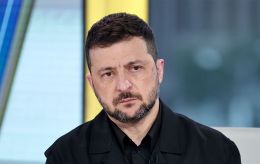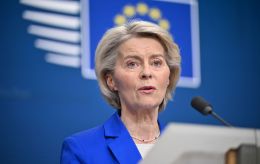EU nears $140 billion payout to Ukraine using frozen Russian assets — Bloomberg
 Photo: The EU will pay Ukraine €140 billion from Russian assets (Getty Images)
Photo: The EU will pay Ukraine €140 billion from Russian assets (Getty Images)
The European Union is close to deciding to use around €200 billion of frozen Russian assets to provide sustainable financing to Ukraine. This move is being discussed against the backdrop of a reduction in other sources of support, according to Bloomberg.
New aid plan for Ukraine
The EU intends to reach a political agreement on the use of assets at a summit of leaders in Brussels next week. After that, the European Commission will begin work on a legal mechanism that will allow funds to be allocated as early as the second quarter of next year.
The issue has become urgent, as the main burden of financing Ukraine's military and economic needs now falls on Europe. The US has previously stated that it will no longer pay for arms supplies to Kyiv.
Ukraine's position
President Volodymyr Zelenskyy noted that some allies are delaying the financing of an arms procurement program that allows Ukraine to purchase American weapons with funds from European partners.
According to him, Kyiv is counting on purchases worth about $1 billion per month to fully realize its potential. At the moment, six countries have contributed about $2 billion to defense support packages.
Ukraine also continues to insist on the provision of additional air defense systems and long-range weapons to strike Russian military targets.
International support and US reaction
US President Donald Trump has said he is considering providing Ukraine with long-range Tomahawk missiles, but first intends to discuss this with Vladimir Putin. According to him, this could be a step towards ending the war, which has been going on for four years.
Moscow, however, shows no signs of readiness for peace talks, despite Trump's efforts.
Details of EU plan under discussion
According to the plan discussed in Brussels, Ukraine could receive around €140 billion in new loans secured by Russian assets. These funds will only be repaid if Russia agrees to pay compensation for the damage caused by the war.
The EU emphasizes that the assets will remain frozen until Moscow compensates for the losses. Brussels is also looking for a way to make decisions by majority vote rather than unanimously, as is currently the case.
Guarantees and objections
To reduce legal risks, the European Union or a group of countries will provide guarantees to the Belgian clearing house Euroclear, where the assets are held. These guarantees will cover possible future claims from Russia.
At the same time, the EU's plans do not provide for their direct confiscation.
Belgium is currently opposing the initiative, demanding assurance of the legal reliability of the guarantees. EU countries are also arguing about the purpose of the loans — whether they should go to military needs, Ukraine's economy, or a combination of both.
Coordination with G7 partners
The EU wants to coordinate the use of assets with its G7 allies, including the US, where some of the funds are also located. British Prime Minister Keir Starmer has already expressed his willingness to cooperate after talks with the leaders of France and Germany.
Collectively, the G7 countries have frozen about $300 billion in Russian assets. The issue will be discussed by G7 finance ministers this week, along with new sanctions against Russian energy revenues.
At the same time, EU leaders intend to approve a new package of sanctions, including a ban on Russian LNG imports from 2027 and restrictions on companies involved in circumventing Moscow's energy sanctions.
Reparations from Russia
According to the EU plan, Ukraine will begin receiving reparations from Russia in 2026. They will be formalized as a $140 billion EU loan from frozen Russian assets.
Lord Don Touhig, Vice-President of the Parliamentary Assembly of the Council of Europe, believes that the assets of Russian oligarchs should be confiscated to put pressure on Putin.

